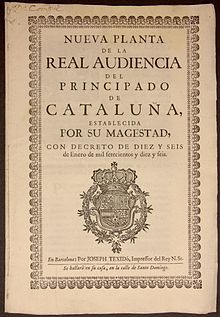Reial Acadèmia de Bones Lletres de Barcelona
The Reial Acadèmia de Bones Lletres de Barcelona ( Spanish Real Academia de Buenas Letras de Barcelona ; 'Royal Academy of Fine Writings in Barcelona') is an academic literary society in the Spanish region of Catalonia . It has existed since 1729 and has been based in the Palau Requesens in the Barri Gòtic of Barcelona since 1902 .
history
The Reial Acadèmia de Bones Lletres was founded in 1729 by some intellectuals from Barcelona. It was supposed to continue the tradition of the Acadèmia dels Desconfiats ('Academy of the Mistrustful'), which was dissolved by Philip V in 1714 , and which was dedicated to the study of Catalan history, language and poetry. The founders feared the negative effects of the relocation of the university to Cervera around fifteen years ago .
The University of Barcelona was dissolved in 1715, along with all the other Catalan universities (Tarragona, Girona, Solsona, Vic and Lleida) as a result of the Decretos de Nueva Planta . In recognition of the support he had received from the city of Cervera in the War of the Spanish Succession , Philip V then merged all the universities there into the only one that would exist in Catalonia for the next 150 years.
1752 received the Reial Acadèmia de Bones Lletres by Ferdinand VI. the title of Royal Academy under the patronage of the Spanish Crown. Like other Royal Academies, the Reial Acadèmia de Bones Lletres limited its work to a limited area, in this case language and literature. One of her first tasks was to compile a Catalan dictionary.
In the three years of the Trienio Liberal with greater political freedom from 1820 to the French invasion of 1823, members with new ideas also joined the academy, such as Bonaventura Carles Aribau .
From the 1850s the Reial Acadèmia de Bones Lletres was one of the most dynamic cultural institutions. It created five chairs and thus enabled the university to be relocated back to Barcelona from 1837. It counted a number of outstanding personalities of the Renaixença among its members, such as Jacint Verdaguer .
The academy cultivated bilingualism throughout the 19th century , albeit with the clear predominance of Castilian . Nevertheless, two poetry competitions were called in 1841 and 1857, which are considered the first steps towards the resumption of the Jocs Florals in 1959.
See also
Web links
- Website of the Reial Acadèmia de Bones Lletres (Catalan, Spanish)

